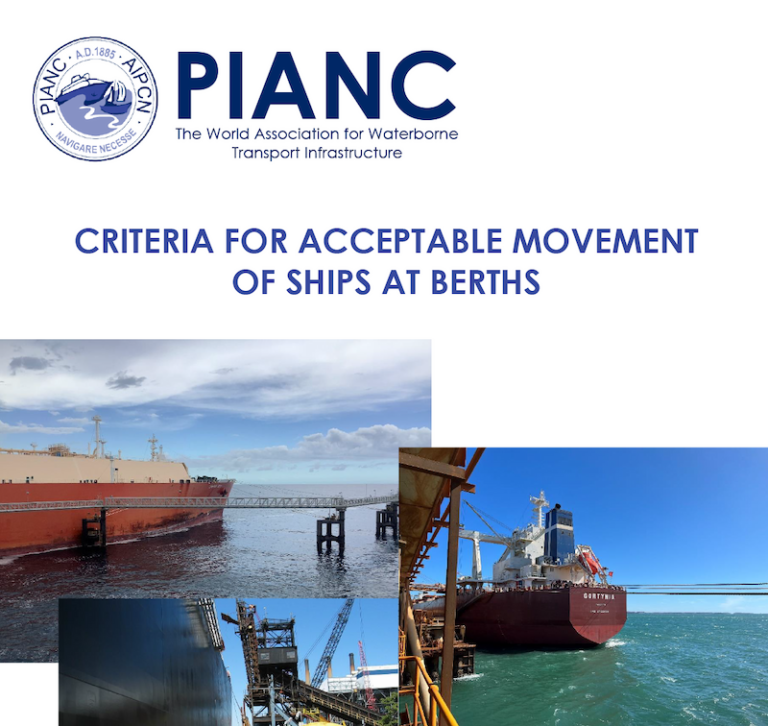MarCom WG 212: ‘Updated Criteria for Acceptable Movement of Ships at Berths’ (2023) was released in June.
Congratulations to PIANC A&NZ members Wim van der Molen and Fabien Cogordan for their work on the report.
The newly issued Updated Criteria for Acceptable Movement of Ships at Berths was developed through a three-year collaborative process that included review of existing relevant literature, data collection through questionnaires issued to multiple terminal operators and port authorities worldwide, and assessment of field collected vessel motions data.
This new report prepared by Working Group 212 builds upon previous guidance (WG24 and WG115) and better reflects current – and emerging – conditions within shipping industry.
“The new report is much more descriptive in how the criteria were reached.”
Dr Wim van der Molen

For Dr Wim van der Molen, whose professional work focuses on projects in port development and operation, participating in the Working Group was an opportunity to share knowledge and experience ‘that I have gained over the years working with the criteria from WG24 that needed to be reviewed and share that knowledge with the new WG.‘
‘The new report,’ he says, ‘is much more descriptive in how the criteria were reached, which data were used, etc., so it gives the reader much more background and potentially options to divert from the criteria if there is reason for that. The previous report (WG24 – 1995) mostly just stated the criteria and gave background of moored ship behaviour in general, not about the constraints for loading and unloading.‘
Takeaways of the report:
‘For most of the vessels and loading methods,’ says van der Molen, ‘the criteria have not or not much changed from the WG 24 criteria. The main change is that most of the new criteria are defined at the location of the ship where loading takes place instead of at the centre of gravity of the ship. That is more sensible and makes some of the criteria stricter when assessing local swaying or heaving at the bow or stern.’
PIANC Working Group reports are a unique process.
‘The process is certainly different from undertaking a commercial project,’ says Dr van der Molen, ‘also different from publishing a scientific paper. Collecting data and after that reaching consensus between the group members takes time. Also, the process of writing the report takes several iterations, first to analyse the data, then writing the chapters and last to modify the chapters in such a way that a unified report is created.’
Of course such a collaborative and thorough process is ‘also a good opportunity for networking and working together with people from many different international organisations.’
“Dedication is what the process requires, but above all interest and a willingness to learn and delve deep…”
Fabien Cogordan

Fabien Cogordan, a Principal maritime engineer with over 20 years local and international experience, was the YP representative on the Working Group. For Fabien, it was a ‘great opportunity to take part in the revision of a very important international guideline which had not been revisited for 27 years. Also an opportunity to work closely with colleagues from all over the world in order to achieve a common objective, which was of great interest.’
‘Dedication is what the process requires, but above all interest and a willingness to learn and delve deep into the subject of interest. The revision of a guideline that we know will be used by so many in the maritime industry requires one to think of the ways in which to make it practical for the numerous readers.’
‘This guideline is more descriptive since the last edition‘ says Cogordan, ‘and yet further simplified. The added material enables a broader understanding of the subject which is useful to the reader for making selections of criteria.’
The working group members considered the following types of vessels in preparing the report: oil tankers, liquid bulk/gas tankers, dry bulk carriers, general cargo vessels, container vessels, RoRo ships, cruise vessels, and smaller vessels. Military and heavy lift vessels have not been considered.
The primary audience for this report is comprised of engineers, port and marine terminal developers, operators, owners, port authorities, regulatory authorities, cargo handling equipment manufacturers, and mariners. More information and links are here.
MarCom Working Group 212
€ 88.00 (76 pages) – purchase here https://www.pianc.org/publications/marcom/wg212
Free for PIANC Members https://www.pianc.org/login
